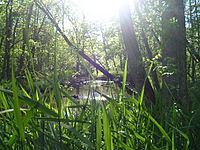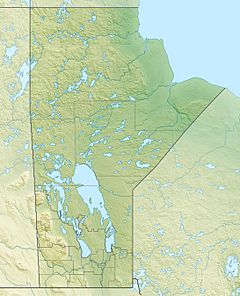Seine River (Manitoba) facts for kids
Quick facts for kids Seine River |
|
|---|---|

La Coulée River is a tributary of the Seine River
|
|
| Country | Canada |
| Province | Manitoba |
| Physical characteristics | |
| Main source | Marchand, Manitoba area 302 m (991 ft) 49°25′00″N 96°27′37″W / 49.41667°N 96.46028°W |
| River mouth | Red River of the North Saint Boniface, Winnipeg, Manitoba 226 m (741 ft) 49°54′00″N 97°06′36″W / 49.90000°N 97.11000°W |
| Basin features | |
| Basin size | 2,509 km2 (969 sq mi) |
The Seine River (French: Rivière Seine) is a cool waterway in southeastern Manitoba, Canada. It's a tributary of the bigger Red River of the North. Did you know it's one of the four main rivers that flow through the city of Winnipeg?
Contents
Discover the Seine River
What's in a Name?
The name "Seine River" comes from an old Aboriginal word, "Tchimâhâgânisipi". This word means "draw net river" or "seine net river". A "seine net" is a special fishing net used to catch fish by drawing it through the water.
Where Does the Seine River Start and End?
The Seine River begins its journey in the Sandilands Provincial Forest. This forest is close to a town called Steinbach. From there, it flows through several communities. These include Marchand, La Broquerie, Ste. Anne, and Lorette.
The river eventually reaches the Red River Floodway near the edge of Winnipeg. At this point, the river's path goes under the Floodway. This special underground tunnel is called the "Seine River Siphon". It helps manage the water flow. The Seine River finally joins the Red River in St. Boniface. This meeting point is just north of a famous area called The Forks.
How the River Changes
The Seine River can look very different depending on the season. After a lot of rain in spring, the river often overflows its banks. This can sometimes cause flooding in nearby areas. But during a dry summer, the river might become very small. It can even be reduced to just a trickle of water.
The River's Path in Winnipeg
Inside the city of Winnipeg, the Seine River takes a very winding and curvy path. It twists and turns a lot before reaching the Red River. The lower part of the river in the city also forms a natural border. It separates the southern part of St. Boniface from the suburb of St. Vital.
The Seine River is a typical "meandering river". This means it has one main channel that winds through a flat, shallow valley. The banks of the river are covered with many trees. However, keeping the river clean has been a challenge in Winnipeg. Sometimes, the river isn't as clean as it could be.


